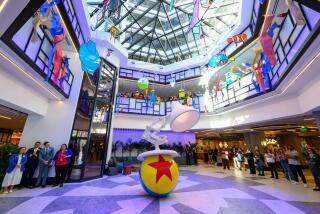The Envelope: Why ‘The Grand Budapest Hotel’ was pretty as a postcard
Some hotels inspire travel postcards, but it was actual hand-tinted travel postcards called Photochroms that were part of the inspiration for “The Grand Budapest Hotel.” Oscar-nominated production designer Adam Stockhausen drew on these and other visual references to create the fictionalized European country of Zubrowka, where a former lobby boy tells of a pastry-pink hotel’s sweetest days under the care of conscientious concierge Monsieur Gustave.
Stockhausen’s third film with director Wes Anderson uses miniature sets, painted backdrops and a lot of location scouting to evoke glimmers of a stylish and civilized 1930s Europe that is no longer — and never was.
Were there real hotels that inspired the Grand Budapest?
We looked at the Grandhotel Pupp in Karlovy Vary [in the Czech Republic], and we looked at the Hotel Bristol, also in Karlovy Vary. The Savoy Hotel in London has an archive of photographs of its history, and they were kind enough to share with us. And we looked at hotels from all over in books.
In contrast to these hotels, how did the 1930s Grand Budapest end up being pink?
Even in our earliest conversations, Wes had this initial push to have the hotel be pink and Monsieur Gustave and all the hotel staff to be wearing purple. So the palette really came from Wes, and then we worked on it and developed it together. There was a lot of yellow in the hotel that we didn’t plan on originally, but it actually worked really nicely with the pink, and all this gold detailing that we didn’t know we’d do when we started.
How did you modify this palette for the 1960s version of the hotel?
When we get into the ‘60s hotel, we were just trying to really be evocative of this period. So I went to the prop warehouse in Babelsberg [Studio in Germany], where we were building, and pulled out old telephones and old lamps and old ashtrays and old flashlights and all these old things that they had that were original pieces from the 1960s in … East Germany, where the studio is actually located. And we pulled out all of these things that are made out of this incredible plastic in these different colors and lined them all up and photographed them. And we settled on the orange and the avocado green and this harvest ocher color, yellow color.
What were some of your other visual references?
We were looking at an archive that the Library of Congress has of these postcards, and it’s a photographic process called Photochrom, these hand-tinted travel postcards. Wes had found them and was really inspired by them. And they just bubbled up over and over and over in the look of how we made things.
Were the miniature sequences influenced by the postcards?
They came out of the Photochroms only in that these postcards have this amazing architecture sometimes. It’ll be these Swiss hotels up on the top of these hills with these funicular trains going up to them, and it’s really majestic and interesting. And Wes wanted to have a very specific geography for the hotel and how it sat above the town. And there are pure digital ways of doing that of course now, but Wes was more interested in the handmade quality of these miniatures.
We had a shop in Babelsberg Studio that was making the full-size scenery, then we had a shop next to it where they were making miniatures. And they made the whole hotel façade, which is all handmade and handcut pieces. And it’s just small, but it’s the exact same stuff that we would use to make it if we were making it full-size. They have these little tiny table saws, little tiny bearing saws. And it’s all very delicate work.
A less delicate set was the hunting trophy room, where the will of Monsieur Gustave’s recently deceased lover is read. Was that place in the original script?
It’s an idea that came out of the scouting. We scouted a hunting lodge in the grandest possible use of the term hunting lodge. It’s really a palace or a castle or something like that in Saxony. You go into this place, and there are these trophies of taxidermy everywhere. I mean, they were so big and so many antlers everywhere, and they were pretty overwhelming and amazing. And so the will reading room seemed like a good place to use that reference.
What do you like best about your job?
I get to make these worlds from my imagination and the people’s with whom I work. And that’s just such an incredible gift.
More to Read
From the Oscars to the Emmys.
Get the Envelope newsletter for exclusive awards season coverage, behind-the-scenes stories from the Envelope podcast and columnist Glenn Whipp’s must-read analysis.
You may occasionally receive promotional content from the Los Angeles Times.






